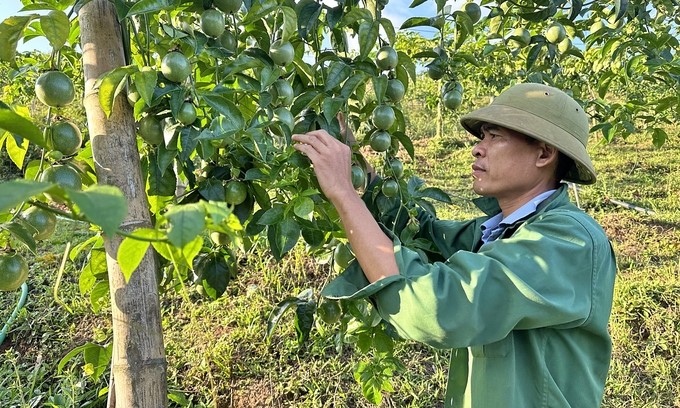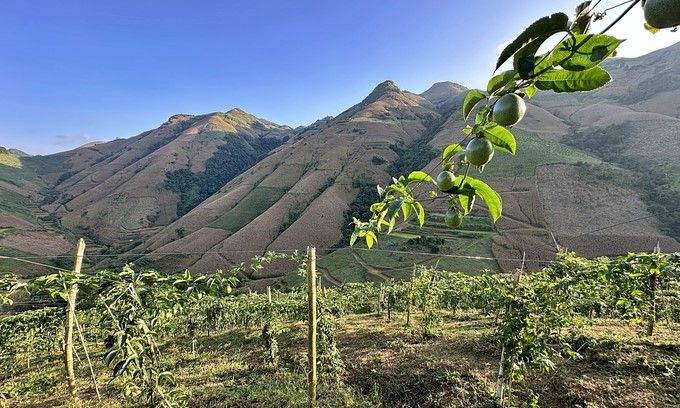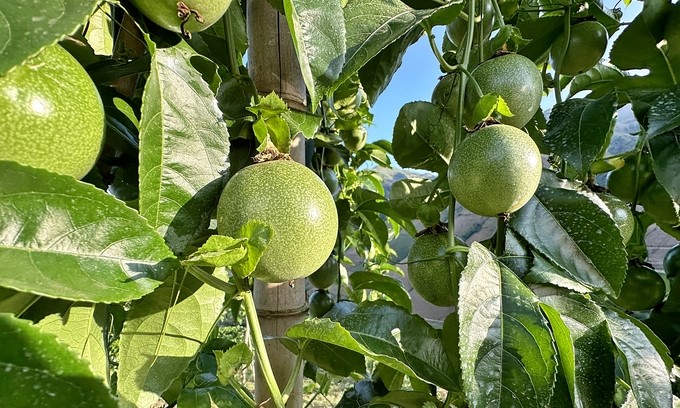November 24, 2025 | 14:58 GMT +7
November 24, 2025 | 14:58 GMT +7
Hotline: 0913.378.918
November 24, 2025 | 14:58 GMT +7
Hotline: 0913.378.918

Passion fruit trees have taken root in Son La for decades. Photo: Duc Binh.
Having been attached to Son La for decades, passion fruit has experienced countless ups and downs with the people here. There were periods (around 2018) when passion fruit reached the price of VND 40,000/kg, but just last year, the price dropped to only a few thousand dongs. The money from the sale is not enough to cover the harvest cost.
In addition to market issues, passion fruit growers must comply with recommendations from specialized units. Nafoods Group JSC, the leading passion fruit unit in Vietnam, provided information that the life cycle of passion fruit trees is short, only 3 years, and they are very susceptible to fungal diseases and viruses. Therefore, when the passion fruit garden is infected and must be destroyed, the soil must rest for 1-3 years before replanting. During this time, people should rotate other crops.
If the passion fruit garden is infected with diseases and there is no passion fruit-growing household around it, people need to destroy the garden and let the soil rest for about 9 months to one year. For concentrated passion fruit gardens, when infected, the soil needs to be rested for 2-3 years.
As a longtime passion fruit grower, Mr. Lo Van Sam, Director of Bao Sam Agricultural Cooperative in Mai Son district, admitted that during the rainy season, passion fruit is susceptible to fungus and pests. To overcome this, he uses biological fungicides and pesticides periodically every 7-10 days. "Because of fungal diseases, it is necessary to buy the right passion fruit variety at reliable addresses and avoid buying seedlings of unknown origin," said Mr. Sam.
Thanks to complying with the care process, Mr. Sam can harvest 30–35 tons of passion fruits/ha. With the selling price of VND 25,000–30,000/kg, after deducting all investment costs, his family can earn a profit of about VND 400 million/ha.
In 2019, the Son La Sub-Department of Crop Production and Plant Protection researched and found a number of solutions to prevent and control diseases on passion fruit trees. Accordingly, for effective prevention and control, people should use five types of medicines, including Mancozeb + Metalaxyl-M (Ridomil Gold 68UG), Azoxystrobin 200g/l + Difenoconazole 125g/l (Amistartop 325SC), and Propineb (Antraco l70WP), on Alternaria sp. and Phytopthoranicotianae diseases.

Compared to other plants, passion fruit is extremely easy to grow and suitable for Son La soil. Photo: Duc Binh.
Thanks to these instructions, people started growing more passion fruit and had stable output at large supermarkets in Hanoi and Ho Chi Minh City. Besides domestic consumption, passion fruit products are also exported to New Zealand, France, and the US markets with strict quality requirements, from fruit size to pesticide residue.
Passion fruit grows well in areas with an altitude of 650–1,000 m and a cool climate ranging from 18 °C to 22 °C. Passion fruit requires a warm and humid climate and cannot tolerate places with a lot of frost and stormy winds. The average suitable rainfall is 1,600 mm or more and evenly distributed, especially during the flowering period with few storms.
Passion fruit trees need water regularly, so growers must provide enough water every day, with an average amount of 10–12 liters/tree, to help passion fruit trees bloom and fruit continuously. The tree requires the most water when the fruit is in its strong growth stage. If the soil lacks water, it will cause the fruit to shrivel and fall, and the ability to create juice for the fruit is poor, affecting the productivity and quality. When there is enough humidity, the garden does not need to be watered because passion fruit trees cannot tolerate waterlogging.
Because it can live on rocky or sandy soil (but must have enough humidity), the passion fruit tree is clearly suitable for the sloping land of Son La, where the slope is mainly below 20° and the topsoil layer is thick, over 30 cm.
Depending on the level of cultivation and level of investment, there are different growing densities, usually ranging from 500 to 600 trees/ha. If the purpose is to export fresh fruit harvested in one crop (1 year of growing), passion fruit can be grown at a density of 800–1,000 trees/ha.
After designing the lot and row, digging holes is implemented. The hole size (width x length x depth) is 60 x 60 x 30 cm. Then, growers apply 10-15 kg of decomposed organic fertilizer + 100 g of N + 150 g of P2O5 + 250 g of lime for one root (equivalent to 2 kg of NPK 5-10-3/root + 250 g of lime/root + 10-15 kg of decomposed manure/root). In case there is no decomposed organic fertilizer, it can be replaced with microbiological organic fertilizer in the amount of 10 kg of decomposed organic fertilizer equal to 1 kg of microbiological organic fertilizer. It is also compulsory to apply basal fertilizer 7–10 days before planting.

Many people in Son La have become better off thanks to passion fruit trees. Photo: Duc Binh.
Ms. Luu Thanh Nga, Head of Plant Protection Office, Son La Sub-Department of Crop Production and Plant Protection, said that for the land without proactive irrigation water, people should plant at the beginning of the rainy season (about from May to August). On the contrary, it can be grown year-round. If the land is not affected by frost and freeze, passion fruit can be planted earlier (October-December of the previous year).
Before planting, farmers must check the soil humidity. If the soil does not reach more than 60% humidity, the water must be supplemented continuously 1-2 times/day.
Passion fruit trees need a lot of water, especially during the flowering and fruit-bearing stages. Therefore, Ms. Nga recommends that if having conditions, people should install a sprinkler or drip irrigation system for the garden. If furrow irrigation is done, it is necessary to let the water penetrate evenly onto the surface of the bed, ensuring that the garden soil is always moist enough throughout the tree's growth and development. However, passion fruit trees are also very afraid of waterlogging, so drainage needs to be monitored promptly during the rainy season.
If a tree is discovered to be dead, people need to beat up seedlings of the correct variety with a growth rate equivalent to the trees in the garden within the first month. After planting, vegetative buds and horizontal buds must be cut promptly so that the grafted buds develop well.
In order for the tree to have guaranteed productivity and quality, controlled bud pruning must be carried out, creating a canopy at a height of 1.7–2 m. Specifically, it is compulsory to prune all vegetative buds, horizontal buds, and flowers growing from the tree trunk to allow main buds to grow on the trellis; only let the horizontal buds grow from a position of 1.7–2m to make the main branch create a canopy. The principle is to only leave level 1 branches and fat, strong level 2 branches to run along the steel wires strung on the trellis; the rest are all let down vertically. The branches that hang vertically at a height of 40 cm above the ground are cut so that the tips do not touch the ground while focusing on nurturing flowers and fruits.
The Son La agricultural sector advises the Provincial People's Committee to develop passion fruit trees by region and build closed production linkage chains from supporting businesses and cooperatives to create safe production areas, ensuring code requirements. Striving by 2025, the passion fruit raw material area in the province will reach 4,000–5,000 hectares, meeting export standards.
Translated by Thu Huyen
/2025/11/22/4018-4-213342_747.jpg)
(VAN) The Mekong Delta Agricultural Experts Club has attracted 143 experts and researchers to participate in providing consultancy and contributing initiatives to the development of one million hectares of high-quality rice.

(VAN) Ca Mau’s development of OCOP products opens a path to increasing cooperatives value, helping boost income, expand markets, and affirm collective economy's role.

(VAN) Turning seemingly ordinary coconut shells into unique jewelry and artwork, Nguyen Bang Nhi spreads the value of local culture through her brand, Cocohand.

(VAN) Results from the Sustainable Durian Model Project in Dak Lak have confirmed the critical role of Yara Viet Nam in transferring advanced nutritional solutions to farmers.

(VAN) In Tuyen Quang province, livestock farmers have introduced effective models and innovative practices that significantly strengthen African Swine Fever prevention and control efforts.

(VAN) This is the study conducted by IRRI and Can Tho University on the rice straw value chain in Mekong Delta showing an economic potential of more than 6.6 trillion VND/year.

(VAN) By participating in cooperative economics, many farmers in Tay Ninh have overcome hardship, mastered clean dragon fruit cultivation techniques.